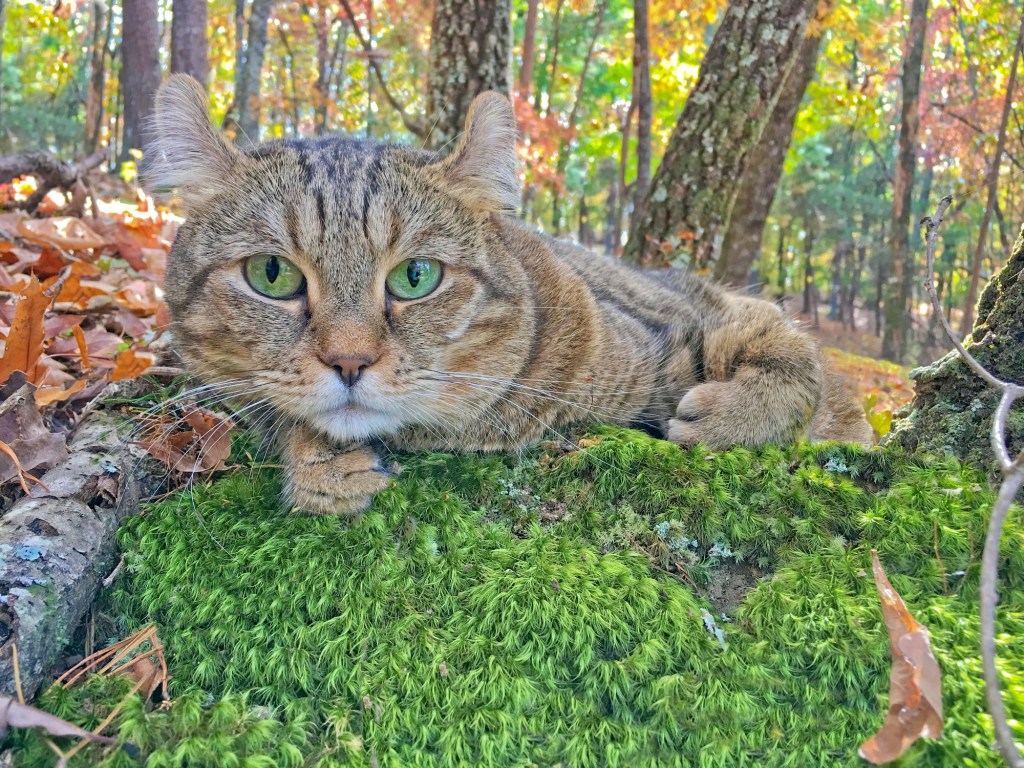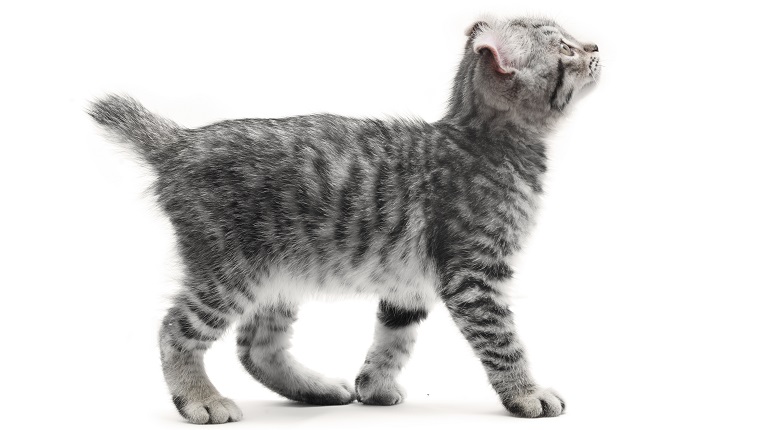The Highlander cat is a distinctive and striking breed known for its unique appearance and playful demeanor. Characterized by its wildcat-like features, this breed typically has curled ears, a bobbed tail, and a robust build. The distinctive curled ears are a result of a genetic mutation, adding to the breed’s charm. The Highlander cat’s coat can vary in length, but it is often dense. These beautiful felines come in a variety of colors and patterns. Despite their wild appearance, the Highlander cat is known for its affectionate and sociable nature.
With a love for interactive play and exploration, Highlander cats are intelligent and adaptable. They thrive in environments that provide mental stimulation and physical activity. They are often described as energetic and agile, displaying a playful nature that persists into adulthood. While the breed is relatively new, having originated in the early 2000s, it has gained popularity among cat enthusiasts who appreciate its distinctive look and engaging personality. Highlander cats make wonderful additions to households that can provide them with the attention and activities they need to stay happy and fulfilled.
When considering a Highlander, it’s advisable to prioritize adopting from rescue organizations or shelters to provide a loving home to a cat in need. However, if you decide to purchase, it’s crucial to choose a reputable breeder. Conduct thorough research to ensure that the breeder follows ethical practices and prioritizes the well-being of their cats. Reputable Highlander breeders prioritize the health and temperament of their cats, conduct necessary health screenings, and provide a nurturing environment for the kitties. This active approach ensures that you bring home a healthy and happy kitty while discouraging unethical breeding practices.
Quick Facts
- Origin: United States
- Size: Medium to large
- Breed Group: Shorthair or Longhair (two variations)
- Lifespan: 7-15 years
- Coat: Shorthaired variety has a dense, short coat, while the longhaired variety has a medium-long, silky coat. Both have a variety of colors and patterns, including tabby, solid, and ticked.
- Temperament: Playful, energetic, affectionate, intelligent, social, loyal, loves to learn, can be trained easily
- Exercise Needs: High
- Training: Easy to train, often learn tricks and enjoy playing fetch
- Grooming: Weekly brushing, with regular bathing for longhaired cats
- Health: Generally healthy, but prone to some genetic conditions
- Distinguishing Features: Lynx-like appearance with curled ears, a long, sloping forehead, a blunt muzzle, wide set eyes, and a bushy tail. Shorthaired variety has a bobbed or short tail.
- Some Highlanders may be polydactyl, but this is not a breed standard.
- The Highlander is considered dog-like, and will even wag its short tail when playing. They can also learn to play fetch and other tricks.
- Highlanders, or Highland Lynxes as they are otherwise known, love to play in water.
Highlander Pictures


-
Affectionate with Family
Some cat breeds are typically independent and aloof, even if they’ve been raised by the same person since kittenhood; others bond closely to one person and are indifferent to everyone else; and some shower the whole family with affection. Breed isn’t the only factor that goes into affection levels; cats who were raised inside a home with people around feel more comfortable with humans and bond more easily.

See Cats Less Affectionate with Family -
Amount of Shedding
If you’re going to share your home with a cat, you’ll need to deal with some level of cat hair on your clothes and in your house. However, shedding does vary among the breeds. If you’re a neatnik, you’ll need to either pick a low-shedding breed or relax your standards. This furniture cover can make it easier to clean up cat hair and keep it off your sofa!
-
General Health
Due to poor breeding practices, some breeds are prone to certain genetic health problems. This doesn’t mean that every cat of that breed will develop those diseases; it just means that they’re at an increased risk. If you’re looking only for purebred cats or kittens, it’s a good idea to find out which genetic illnesses are common to the breed you’re interested in.
-
Potential for Playfulness
Some cats are perpetual kittens—full of energy and mischief—while others are more serious and sedate. Although a playful kitten sounds endearing, consider how many games of chase the mouse-toy you want to play each day, and whether you have kids or other animals who can stand in as playmates. A classic wand cat toy like this one is perfect for playful felines!
-
Tendency to Vocalize
Some breeds sound off more often than others with meows, yowls, and chattering. When choosing a breed, think about how the cat vocalizes and how often. If constant “conversation” drives you crazy, consider a kitty less likely to chat.
-
Kid-Friendly
Being tolerant of children, sturdy enough to handle the heavy-handed pets and hugs they can dish out, and having a nonchalant attitude toward running, screaming youngsters are all traits that make a kid-friendly cat. Our ratings are generalizations, and they’re not a guarantee of how any breed or individual cat will behave; cats from any breed can be good with children based on their past experiences and personality.
-
Friendly Toward Strangers
Stranger-friendly cats will greet guests with a curious glance or a playful approach; others are shy or indifferent, perhaps even hiding under furniture or skedaddling to another room. However, no matter what the breed, a cat who was exposed to lots of different types, ages, sizes, and shapes of people as a kitten will respond better to strangers as an adult.
-
Easy to Groom
Some breeds require very little in the way of grooming; others require regular brushing to stay clean and healthy. Consider whether you have the time and patience for a cat who needs daily brushing. You should definitely pick up this awesome de-shedding tool for cats of any hair length!
-
Intelligence
Some cat breeds are reputed to be smarter than others. But all cats, if deprived the mental stimulation they need, will make their own busy work. Interactive cat toys are a good way to give a cat a brain workout and keep them out of mischief. This scratcher cat toy can keep your smart kitty busy even when you’re not home!
-
Pet Friendly
Friendliness toward other household animals and friendliness toward humans are two completely different things. Some cats are more likely than others to be accepting of other pets in the home.
Highlander History
The Highlander was originally developed by a breeder named Joe Childers back in 1993. The intention was to produce a domestic feline that combined a striking wild cat look with social and playful personality traits. Despite originally having the word Lynx in their name, the mixed breed doesn’t actually contain any wild cat genes in their makeup. The Highlander was officially acknowledged by the International Cat Association (TICA) in the year 2008. These days, you may find Highlanders in shelters or in the care of rescue groups. So make sure to consider adoption if you decide that this is the mixed breed for you!
Highlander Size
The Highlander is a medium-to-large-sized cat. As is always the case, exact size standards might vary. Most Highlanders weigh in at 10 to 20 pounds. That said, some may be smaller or larger than average.
Highlander Personality
Highlander cats are athletic and energetic felines. You’ll need to be able to provide a large enough living space for them to run around in, along with adding interactive toys to the environment. The Highlander is a very intelligent cat–in many cases they can be taught to play fetch and pull off tricks! Balancing out the Highlander’s upbeat side, these cats are also very social and loving. They enjoy being around humans and interacting with them, and despite the big cat angle to their heritage, they’re affectionate towards the people in their life. The cat also does well around children, acting like a new play friend. Unlike most other cat breeds, the Highlander also likes water, so don’t be surprised to see them playing with water in the bathtub or from a running tap!
Highlander Health
Highlanders are generally considered to be healthy cats; although, they can be predisposed to the same conditions that the Desert Lynx and Jungle Curl breeds face. As always, it’s important to schedule regular wellness visits with your cat’s vet. There aren’t any known breed specific health problems associated with the Highlander, but always keep an eye out for signs that your cat might be in distress or pain.
Highlander Care
As with all cats, it’s important to keep up your Highlander’s regular veterinary checkups to detect any health concerns early. Your vet can help you develop a care routine that will keep your cat healthy.
Beyond scheduling yearly wellness visits with your vet, you’ll want to add a scratching post to your Highlander’s living environment. This can help promote healthy scratching and keep the cat’s nails in good condition.
The Highlander’s ears should also be examined regularly for signs of dirt building up or possible infection. It’s also advisable to talk with your vet about starting a regular teeth brushing regimen that will suit your Highlander. Your vet can advise you about specific brands and techniques.
It’s important to underline that the Highlander mixed breed needs a higher than usual amount of exercise, so make sure to add at least one cat tree or piece of interactive furniture to your home before adopting one.
Highlander Coat Color And Grooming
The Highlander is a mixed breed of cat that you’ll see in a wide range of colors and patterns. It’s common to see them with solid coat colors or with tabby or lynx point markings.
When it comes to grooming, most Highlanders are fairly low maintenance, with their short hair requiring only a quick weekly brushing. This will help lessen the likelihood of hairballs and mats forming. Although it should be noted that some Highlanders are long haired felines–in which case you’ll need to aim for closer to daily brushing sessions.
In terms of climate, the Highlander is generally an adaptable breed of cat. Although you should always make sure that there’s enough shade and fresh water available during the hotter months.
Children And Other Pets
The Highlander is a super friendly and outgoing feline who does very well with young children. Just be sure that early socialization takes place and boundaries are properly set on both sides, and supervise early interactions between kids and cats.
When it comes to other household pets, the Highlander fares well with many domestic animals, including dogs. Always supervise early interactions between the new cat and existing pets.
Ultimately, early socialization really pays off with this mixed breed. Make sure to reward your Highlander for good behavior when you bring them home to your family!
Highlander Rescue Groups
It may be hard to find a breed specific rescue for Highlanders because they are a mixed breed. However, you may want to try shelters and rescues that cater to all types of cats, including Highlanders, as well as your local shelter. Here are some nonprofit rescues you can try:
More Info For You
If you’re also looking for a dog, check out DogTime’s dog breed page!





